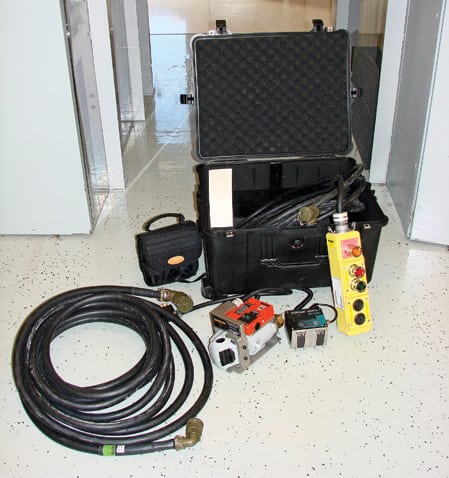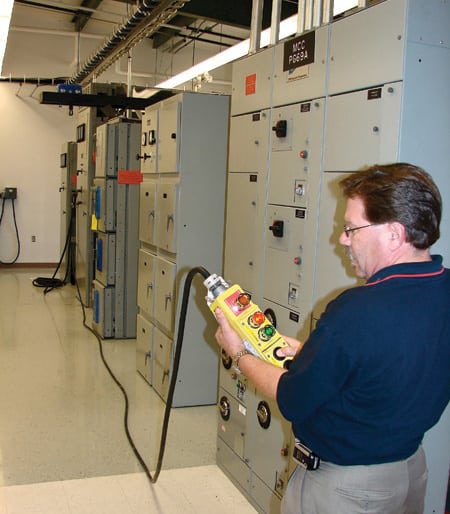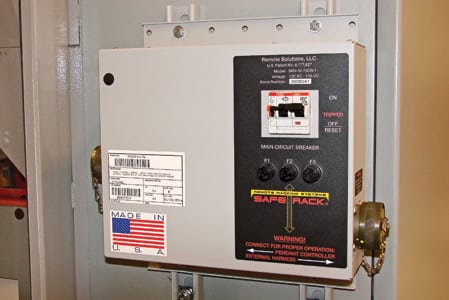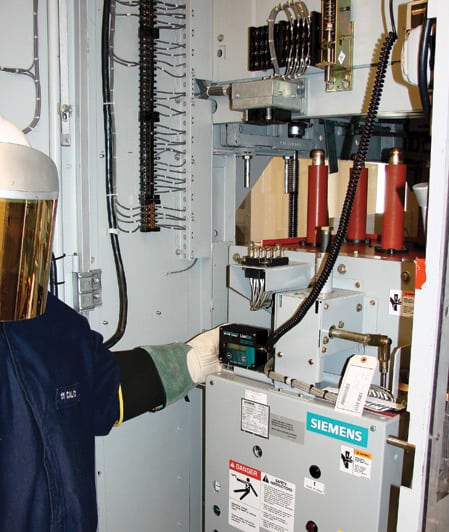Arc flash protection should be job No. 1
Assumptions and complacency are two of safety’s worst enemies. If the following story hits uncomfortably close to home for you, it will have served its purpose.
In January 1993, two employees were killed and three were seriously injured by an electrical arc flash at a Texas power station.
The dead employee—an operator in a full flash suit—had racked-in a circuit breaker and sent the close command, but the breaker failed to close. With the breaker indicator showing that it was still open, the operator began racking-out the breaker to troubleshoot the problem with his supervisor looking on. Neither knew that the breaker had received the close command. The breaker had unlatched and begun to close, but the mechanical problem prevented it from completing the operation.
As a consequence, the operator attempted to rack out the breaker even as it was receiving a close command. When he was finally able to move the breaker, the mechanical bind was relieved and the breaker closed while it was partially racked-out. The result was an electrical arc flash and explosion that critically burned the operator and the supervisor and slammed them into wall. Both were killed. The arc flash then traveled around a corner and burned three other workers. All of this carnage occurred within milliseconds.
The operator, in addition to wearing a full-body flash suit while racking the breaker, did everything that National Fire Protection Association (NFPA) and Occupational Safety and Health Administration (OSHA) regulations required. Although the suit provided some protection, it did not save the operator’s life. The moral of this story: If the arc flash burn doesn’t get you, the high-energy blast effects will. Entergy learned the lesson quickly; immediately after this accident, the company began retrofitting all of its rackable breakers rated at 2,300 volts or higher with remote racking systems (see box).
Electricity’s dangerous downside
Few electrical phenomena are as dramatic as arc flash. When current leaves its assigned path and short-circuits through the air between conductors, or between a conductor and ground, temperatures in the resulting arc can soar well beyond that of the sun’s surface (about 10,000F) in just a fraction of a second. The host of hazards produced includes electromagnetic radiation, superheated plasma, a sound pressure wave, and shrapnel.
Each arc flash event can cost millions of dollars in medical expenses, equipment replacement and repair, lost work hours and production, lawsuits, and higher insurance premiums. The human toll from arc flash burns and other injuries is especially acute.
A 10-year study by Électricité de France found that arcing caused 77% of all recorded electrical injuries. Similarly, one corporation noted that up to 80% of its electrical injuries involve thermal burns due to arcing faults. The U.S. National Institute of Occupational Safety and Health (NIOSH) tabulated 44,363 electrical-related lost-workday cases from 1992 to 2001. Arc flash burns (Figures 1 and 2) accounted for 17,101 (or about 39%) of those cases.
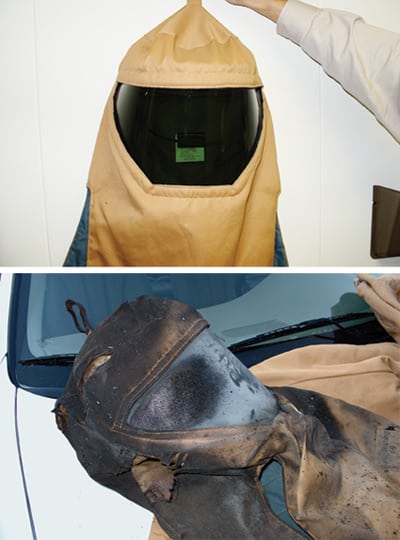
1. In your face. Flame-resistant shields and hoods protect the head, face, and eyes against the ultraviolet, infrared, radiant, and convective energies unleashed in an arc flash event. The damaged hood (bottom) protected a worker from serious injury during such an incident. The intense thermal energy produced by the flash caused the fabric to break open and char and the shield to bubble and blacken. Courtesy: Ferraz Shawmut High Power Test Laboratory
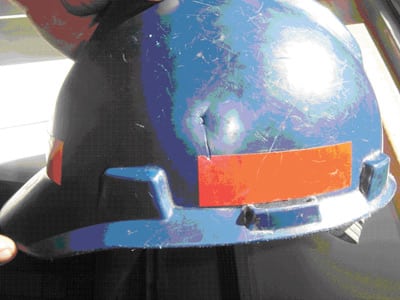
2. Hard head. A hard hat worn by an electrician exposed to an arc flash prevented injury from shrapnel propelled by the event. Flame-resistant clothing protected him from thermal burns. Courtesy: DuPont
Although arc flash phenomena have been of concern for a century or more, there are surprising gaps in what is known about them and how to protect workers from their effects. In an effort to fill this knowledge gap, the IEEE and NFPA have joined forces to explore the many aspects of arc flash and accompanying arc blast phenomena and determine how to ensure worker safety when arc flashes occur. This article first reviews these phenomena and then details what the IEEE/NFPA program hopes to accomplish.
Rogues’ gallery
The dramatic release of energy as electrons pass across a narrow arc through air takes many forms. Extreme heat is just one: The temperature at the point of flashover and in the arc can rise to between 5,000F and 30,000F, depending on the current level and other factors.
The energy packed into just a few tenths of a second also generates an explosion that sends pressure waves, debris, molten metal, and a plasma containing toxic gases and particulates expanding outward at hundreds of miles per hour (Figure 3). As a result, workers in the vicinity of an arc flash are at risk of multiple traumas, such as severe burns, smoke inhalation, eye damage, hearing loss, collapsed lungs, fractures, puncture wounds, loss of consciousness, and even death. Survivors may endure permanent disabilities and a reduced quality of life.

3. Bright as the sun. Photos taken at 1-microsecond intervals at the Ferraz Shawmut High Power Test Laboratory in Newburyport, Mass., illustrate the development of an arc flash as a jet of hot, ionized gas elongates from the sides of vertical conductors terminating in an insulator block. The conductors are part of a three-phase system energized at 480 V and 42 kA. The jet, which had its farthest reach in image "d" (shown impacting the vertical plates of a calorimeter), is shown collapsing in "e." Courtesy: Ferraz Shawmut High Power Test Laboratory
The sheer amount of thermal energy released in arc flashes and transferred via radiation, convection, and conduction makes burns the most frequent injury in these events. The extent of burns depends on the duration and temperature of the flash and its distance from the victim(s).
Laboratory measurements of the concussive forces associated with arc flash have found sound levels of 1,400 decibels and pressure levels of 2,160 psi 2 feet from the flash. As fans of heavy-metal music know, hearing is damaged by just 140 dB. Injuries associated with high sound pressure waves usually involve hearing loss but can also include burst eardrums and dislocated ossicles (bones). Elsewhere in the body, the waves can break alveoli in the lungs, producing respiratory distress, and/or cause profuse intestinal bleeding, a ruptured spleen or liver, and progressive peritonitis. They also can cause injuries if they are strong enough to knock personnel down or throw them for a distance.
The burst of energy in an arc flash expels hot gases containing, in part, copper vaporized from conductors, metal vaporized from enclosure walls, smoke from the incineration of insulation, paint and other materials, and copper oxides formed in an arc. The vaporized copper content can be significant: Just 2 to 3 inches of vaporized conductor can yield more than 75 ft3 of copper vapor. The toxic and corrosive plasma has its greatest impact on lungs, skin, eyes, and other mucus membranes.
The electromagnetic radiation produced by an arc flash is highly variable and can occur over a wide bandwidth that includes radio, microwave, infrared (IR), visible, ultraviolet (UV), and X-ray frequencies. Experience indicates that the IR, visible, and UV waves do the most damage.
IR radiation near the visible spectrum (just beyond red wavelengths) can injure the cornea and lens, whereas longer IR wavelengths are absorbed as heat. Excessive visible radiation can damage the skin and cause partial or total loss of sight. UV radiation also can harm the eyes. Ionizing radiation (shorter wavelengths, such as higher-frequency UV and X-rays) can strip electrons from atoms, creating waves of frequencies that can damage DNA and cause cancers.
As the blast wave expands outward at supersonic speed, it turns equipment, tools, and objects in its path into high-velocity projectiles. Equipment enclosures can affect the path and intensity of the energy released in arc flashes. For instance, the energy of an arc blast surging through an open enclosure door is focused through a relatively small opening. Many factors affect the impact of an arc flash event, including the size and shape of the enclosure, the size and placement of its door, and the equipment inside.
A physics-based approach
Any company that generates, transmits, distributes, or uses electricity at high, medium, or even low voltages will find it difficult to completely protect its workers from arc flash and arc blast hazards. The task is even more difficult for users of direct-current systems that cannot be de-energized. The biggest obstacle to protection is the inability to predict the type and magnitude of arc flash effects in a way that would allow the optimal use of personal protective equipment (PPE) and work practices.
The need to quantify arc flash and blast has led to a call for a physics-based approach capable of accurately describing the phenomena. Given their complexity, any description would likely involve an algorithm containing many equations. A key goal of the IEEE-NFPA joint research and testing initiative, which is just getting under way, is to gather data on all of the expressions of energy during arc flash and arc blast events. This data then could be used to help solve the equations. The data also could serve as the foundation of practical safeguards against arc flash and blast for those who work on or near electrical equipment.
The IEEE/NFPA Arc Flash Collaborative Research Project is a multiyear effort encompassing more than 2,000 test protocols. So far, over $1.8 million of the $6.5 million needed to fund the program has been contributed by power companies, manufacturers, and test and certification organizations. Major donors to date include HydroOne, Bruce Power, Underwriters Laboratories, and Ferraz Shawmut.
The initial phase of the project will explore published and unpublished information on arc flash and blast to build a coherent picture of what is known about these phenomena. This will lead to a research and test plan that seeks to tie the electrical characteristics of equipment to arc-fault hazards. The program will go well beyond what was done in the past. For instance, most arc fault studies to date have involved controlled conditions and stabilized arcs between opposing electrodes. In real life, turbulent arcs often occur between parallel electrodes and vary by several orders of magnitude along their length and with time.
The extreme temperatures in arcing faults make burns the predominant injury they cause. As a result, the program will focus on thermal mechanisms. Testing will build on current methods for measuring how arcing faults transfer thermal energy via convection, conduction, and radiation and how these processes affect human tissue and clothing. This includes understanding how much of the electromagnetic spectrum released in arc faults falls into IR wavelengths, as well as evaluating the thermal energy conducted through PPE when a plasma cloud passes over a face shield or clothing. This can involve a significant amount of heat because copper vapor, which boils at 4,500F, makes up much of this cloud.
The program will survey existing protocols for measuring the thermal effects of arcing faults on a human body and, when needed, create new protocols that encompass such variables as arcing time, working distance, frequency, electrode gap, voltage, current, and the number of phases. It will refine existing test methods and instrumentation, such as measuring heat flux and relating it to burns and upgrading calorimeter specifications.
In addition, it will review a NIOSH electrical injury database to identify measures that could have limited injury and create a template for obtaining future electrical incident information. The program also will investigate low-current (1 kA to 10 kA), long-duration arcs, because the energy transfer in such events is often so great that available PPE cannot protect against it.
Beyond thermal testing
The joint initiative also will break new ground by studying nonthermal phenomena associated with arc flash and the hazards they create. It will look to create an initial arc flash energy balance that includes radiation, pressure, and plasma. Following are some of the approaches planned to reach that goal.
The program will measure the intensity of IR, visible, UV, and other potentially injurious electromagnetic energies in an arcing fault and how they affect the body. It will explore such areas as retinal damage due to visible and UV light and may involve placing detectors behind safety goggles and other eye safety gear during arc flashes. It may also evaluate the effects of brief exposure to ionizing radiation in arc flashes.
Because little test or injury data on the high-pressure fronts created in arc blasts are available, the program will seek basic data on their intensity and consequences. It will record sound pressures and frequencies at various distances, angles, and times from a flash source, as well as the injury potential of these waves and how well shields and hoods attenuate them. Other tests will include comparing pressure waves in open areas and enclosures and determining blast pressures in arcs interrupted in one cycle or less. The program will also seek to relate the substantial understanding of pressure waves created by explosives to those formed in arc blasts.
The program will evaluate the shrapnel and molten metal ejected during arc faults. It will create a database for arc flash shrapnel injuries, to allow the frequency and severity of these injuries to be defined. It also will formulate arc flash shrapnel test protocols and use them to relate shrapnel mass and velocity to electrical parameters.
The program will also conduct pioneering research into the toxic and corrosive particles and vapors present in arc flash plasmas and how they impact personnel and PPE. This will involve determining the feasibility of generating toxic materials in laboratory-generated arc flashes and finding ways to define the amount and type of materials generated. This is a challenging area of study, given the variability of the mass, composition, and temperature of arc flash plasma clouds.
The program will evaluate arc flash events in direct current systems, which are commonplace in some industries and which are increasing as the demand for battery back-up energy in information technology systems increases. This part of the program also calls for developing a method to evaluate arcing faults in DC systems.
Finally, enclosure testing will seek to expand current understanding of how enclosures, their doors, and the equipment they contain affect arc flash properties and the potential for injury. Testing of "arc in a box" events will consider such factors as enclosure size and shape, door construction, arc location and orientation, electrical system capacity, grounding, protective-device bus orientation and spacing, and the components contained in the box.
Current PPE and work practices tend to focus on the thermal and radiative effects of arc flash, so they may not protect well against pressure waves, plasma, or shrapnel. An underlying, ongoing theme of the joint initiative will be to understand how well gloves, safety goggles, flame-resistant clothing, safety shoes, and other PPE items protect workers against the full range of arc flash and blast hazards.
Who will benefit
Electricians, mechanics, HVAC personnel, and other plant workers are at risk from arc flash when they work on panel boards, motor control centers, switchgear, transformers, and many other power system elements. Although lockout/tagout programs help prevent arc flash events, they do not eliminate them.
Arcing faults can occur through human error, especially during voltage testing and system shutdown and start-up. Bear in mind that a circuit may remain energized even after it is believed to be shut down because of inaccurate signs and labels, worker confusion, faulty wiring, or poor work practices. Arcing faults might result from damaged insulation, accidental contact with energized components, equipment with incorrect short-circuit ratings, and corrosion and impurities that provide a current path.
Because arc flash and arc blast are ever-present hazards for anyone working on or near electrical equipment, the IEEE/NFPA Arc Flash Collaborative Research Project will be an intensive effort to gain deeper insight into these phenomena. This knowledge will then help create better industry safety standards, work practices, PPE, and equipment to help reduce electrical injuries, fatalities, and property damage. The effort will benefit all stakeholders in the electric power industry, from utilities to equipment and PPE vendors to regulatory agencies and insurers.
The data and recommendations from the joint initiative will help the IEEE and NFPA strengthen arc flash safety standards—specifically, IEEE 1584, "Guide for Performing Arc-Flash Hazard Calculations," and NFPA 70E, "Standard for Electrical Safety in the Workplace." IEEE 1584 provides methods for determining the flash hazard area and how much energy workers can potentially be exposed to when working on or near electrical equipment. NFPA 70E, which is widely cited by OSHA, covers work practices such as employee training, risk evaluation, safe work conditions, approach boundaries, and PPE use. In addition, it is anticipated that the data and recommendations will lead to improvements in electrical equipment and power system designs, enhancements in maintenance tools, instruments, and work practices, and advances in personal protection technology.
The more-refined understanding of arc flash phenomena, and the gains in on-the-job safety that it will make possible, will help companies boost operating efficiency and productivity. It will enable more effective PPE, safer equipment, and better training. Better protection from arc flash also promises to decrease expenses for injuries and property damage, lower insurance claims and premiums, and reduce litigation and workers’ compensation claims.
—Those interested in learning more about, or contributing to, the IEEE/NFPA Arc Flash Collaborative Research Project should contact Sue Vogel at IEEE (732-562-3817, [email protected]) or Mark Earley at NFPA (617-984-7400, [email protected]). A prospectus on the project is available online at http://standards.ieee.org/esrc/arcflash/index.html.
